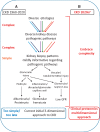Clinical proteomics in kidney disease as an exponential technology: heading towards the disruptive phase
- PMID: 28396735
- PMCID: PMC5381206
- DOI: 10.1093/ckj/sfx023
Clinical proteomics in kidney disease as an exponential technology: heading towards the disruptive phase
Abstract
Exponential technologies double in power or processing speed every year, whereas their cost halves. Deception and disruption are two key stages in the development of exponential technologies. Deception occurs when, after initial introduction, technologies are dismissed as irrelevant, while they continue to progress, perhaps not as fast or with so many immediate practical applications as initially thought. Twenty years after the first publications, clinical proteomics is still not available in most hospitals and some clinicians have felt deception at unfulfilled promises. However, there are indications that clinical proteomics may be entering the disruptive phase, where, once refined, technologies disrupt established industries or procedures. In this regard, recent manuscripts in CKJ illustrate how proteomics is entering the clinical realm, with applications ranging from the identification of amyloid proteins in the pathology lab, to a new generation of urinary biomarkers for chronic kidney disease (CKD) assessment and outcome prediction. Indeed, one such panel of urinary peptidomics biomarkers, CKD273, recently received a Food and Drug Administration letter of support, the first ever in the CKD field. In addition, a must-read resource providing information on kidney disease-related proteomics and systems biology databases and how to access and use them in clinical decision-making was also recently published in CKJ.
Figures


Similar articles
-
Urinary peptide-based classifier CKD273: towards clinical application in chronic kidney disease.Clin Kidney J. 2017 Apr;10(2):192-201. doi: 10.1093/ckj/sfx002. Epub 2017 Mar 29. Clin Kidney J. 2017. PMID: 28694965 Free PMC article.
-
Novel Urinary Biomarkers For Improved Prediction Of Progressive Egfr Loss In Early Chronic Kidney Disease Stages And In High Risk Individuals Without Chronic Kidney Disease.Sci Rep. 2018 Oct 29;8(1):15940. doi: 10.1038/s41598-018-34386-8. Sci Rep. 2018. PMID: 30374033 Free PMC article.
-
The long path towards implementation of clinical proteomics: Exemplified based on CKD273.Proteomics Clin Appl. 2017 May;11(5-6). doi: 10.1002/prca.201600104. Epub 2017 Jan 17. Proteomics Clin Appl. 2017. PMID: 28019083 Review.
-
Utility of the CKD273 peptide classifier in predicting chronic kidney disease progression.Nephrol Dial Transplant. 2016 Feb;31(2):249-54. doi: 10.1093/ndt/gfv062. Epub 2015 Mar 19. Nephrol Dial Transplant. 2016. PMID: 25791724
-
Urinary proteomics and molecular determinants of chronic kidney disease: possible link to proteases.Expert Rev Proteomics. 2014 Oct;11(5):535-48. doi: 10.1586/14789450.2014.926224. Epub 2014 Jun 24. Expert Rev Proteomics. 2014. PMID: 24957818 Review.
Cited by
-
Chronodisruption: A Poorly Recognized Feature of CKD.Toxins (Basel). 2020 Feb 28;12(3):151. doi: 10.3390/toxins12030151. Toxins (Basel). 2020. PMID: 32121234 Free PMC article. Review.
-
CKD: The burden of disease invisible to research funders.Nefrologia (Engl Ed). 2022 Jan-Feb;42(1):65-84. doi: 10.1016/j.nefroe.2021.09.005. Nefrologia (Engl Ed). 2022. PMID: 36153901 Free PMC article.
-
The chaos of hypertension guidelines for chronic kidney disease patients.Clin Kidney J. 2019 Sep 28;12(6):771-777. doi: 10.1093/ckj/sfz126. eCollection 2019 Dec. Clin Kidney J. 2019. PMID: 31807290 Free PMC article.
-
Novel strategies in nephrology: what to expect from the future?Clin Kidney J. 2022 Sep 20;16(2):230-244. doi: 10.1093/ckj/sfac212. eCollection 2023 Feb. Clin Kidney J. 2022. PMID: 36755838 Free PMC article. Review.
-
RICORS2040: the need for collaborative research in chronic kidney disease.Clin Kidney J. 2021 Sep 23;15(3):372-387. doi: 10.1093/ckj/sfab170. eCollection 2022 Mar. Clin Kidney J. 2021. PMID: 35211298 Free PMC article.
References
-
- https://singularityhub.com/2014/06/10/staggering-promise-of-exponential-... (21 February 2017, date last accessed)
-
- Diamandis PH, Kotler S.. Bold: how to go big, create wealth and impact the world. London, UK: Simon & Schuster, 2015
-
- James P. Protein identification in the post-genome era: the rapid rise of proteomics. Q Rev Biophys 1997; 30: 279–331 - PubMed
-
- Aicher L, Wahl D, Arce A. et al. New insights into cyclosporine A nephrotoxicity by proteome analysis. Electrophoresis 1998; 19: 1998–2003 - PubMed
-
- Liotta LA, Kohn EC, Petricoin EF.. Clinical proteomics: personalized molecular medicine. JAMA 2001; 286: 2211–2214 - PubMed
LinkOut - more resources
Full Text Sources
Other Literature Sources
Miscellaneous

